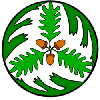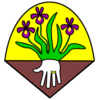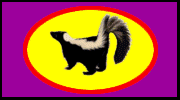
|

|

|
Bermuda and Zoysia Lawn Care
Paul Burns, Garden Design & Education©
Bermuda and zoysia are excellent grasses for Atlanta. They are fine textured, yet tough and durable. They spread by runners, filling in gaps and holes quickly. They have a very manicured look when properly maintained. Being warm-season grasses, they are beautiful from late April to October, then go dormant for the winter, saving you from mowing all year.
Renovation
If you have inherited a bermuda or zoysia lawn that has seen better days, there are several steps you can take to restore the vigor of your lawn.
Aerate: Rent a core-aerating machine and run it back and forth over your damp lawn to loosen the soil by pulling out 3" by 1/2" plugs of soil. The soil in these plugs will breakup and refill the holes with loose soil. This will allow rain to penetrate and be absorbed, and will allow the roots to spread into the loose soil for stronger roots. This is usually done in the spring.
Lime: Dolomitic limestone adds the essential elements calcium and magnesium to the soil, while raising the pH to an alkaline level preferred by grasses. A soil sample taken to your county extention agent gives you an accurate amount of lime to add to your soil, but as a general rule, you need to add 40 pounds (one bag) of lime to 1000 sq.ft. of lawn the first time you work on it, and add an additional 20 pounds (1/2 a bag) per 1000 sq.ft. each year.
Fertilizer: Lawns need feed three times a year with a good fertilizer to maintain that rich green color, and to keep it strong and healthy. Use a good fertilizer with slow-release nitrogen, phosphorus, potassium and trace elements like copper, zinc, and iron to prevent nutritional deficiencies. Bermuda and zoysia usually get fertilized in April, June, and August.
Seeding: You don't need to re-seed bermuda and zoysia because they spread by runners, and are so rambunctious that they will fill in bald areas as long as the soil doesn't collect water, and isn't compacted. (Aeration is the cure for both of these problems) If a bald patch is very large, you may want to dig up plugs or clumps from thick areas to plant into the bald areas to get things to fill in quicker. If the areas are bald due to shade, it may be time to convert the bald areas to a pine island.
Installation
Sod: Hybrid bermuda and zoysia are planted as sod. Kill all the existing vegetation with Round-up, and wait two weeks for the Round-up to work. Till the entire area to loosen the soil, adding 40 pounds (one bag) per 1000 sq.ft. of dolomitic lime. Till in 1" of organic matter like Nature's Helper or compost if it is economically feasible. Rake the area smooth, removing and clods, stones, and debris. Measure the area carefully to determine the square footage (length X width = area) and buy the amount needed to cover the area.
Start with your longest straight side, and lay the sod on the prepared ground, keeping the seams close. Stagger the seams between rows, like bricks are laid, for strong seams. Water thoroughly when finished, then water lightly once or twice a day to keep the sod moist. When the sod has grown enough to mow, fertilize with a commercial lawn starter fertilizer ( 1 bag per 5000 sq.ft.). As the sod begins to root into the soil, start tapering the frequency of water to once a week.
Seed: Bermuda is available as seed. Modern bermuda varieties are almost as short and as dense as the hybrid bermudas. To install, prepare the ground as described above. Sow the bermuda seed at a rate of 2 pounds per 1000 sq.ft. Since bermuda seed is small, most people mix it with sand (10 parts sand to 1 part seed) to give enough bulk to spread easily. Spread a bale of wheat straw on each 1000 sq.ft. to help retain moisture. Water thoroughly when finished, then water lightly once or twice a day to keep the seed moist enough for germination. The seed will take 2 to 3 weeks to germinate. Once the grass is up, slowly taper back the waterings until the lawn is receiving a weekly soaking. The straw will be chopped up by your mower once you begin to mow the lawn. Seeding is best done during late April through June.
Maintenance
Once your lawn is established, you can keep it growing healthy and vigorous with proper maintenance.
Cutting: Cut your bermuda and zoysia 1-1 1/2" tall. During the summer you can cut it at 2" for drought protection. You can leave the clipping as long as you are cutting often enough to be removing 1/2" or less. Always use a sharp mower blade.
Lime: Add 20 pounds of dolomitic lime per 1000 sq. ft. each year (or whatever your soil sample recommends).
Fertilization: Fertilize three times a year with a quality fertilizer to provide slow-release nitrogen, phosphorus, potassium and trace elements like copper, zinc, and iron to prevent nutritional deficiencies. Bermuda and zoysia are usually feed in April, June, and August.
Aerate: Aerating annually helps fight compaction, and improves drainage and root growth. This is usually done in the spring, during the active growing season, or in February before you apply a pre-emergent herbicide. Professional lawn care companies and golf courses aerate religiously. This is one reason they have great looking grass.
Weed Control
Many weeds such as crabgrass can be prevented by using a pre-emergent herbicide. Dacthal, Treflan, Balan, or others are applied evenly in the spring before seeds begin to germinate. This creates a barrier that causes seedlings to wither and die. This doesn't affect established plants, just seeds and seedlings. Normally people apply these when the Forsythia and Bradford pear are in bloom.
Established broad-leaved weeds can be killed with Ortho's Weed-B-Gon for Southern Lawns. This will kill most broad-leaved weeds without killing the zoysia or bermuda. Established crabgrass can be killed with MSMA. This burns up crabgrass without hurting the zoysia or bermuda. It isn't used on fescue because it burns that too.
Nutgrass in the zoysia or bermuda can be a problem. Image can help to control it, if used according to directions.
If the bermuda or zoysia escapes into your flower beds and becomes a pest, you can spray it with Ortho's Grass-B-Gon. This weedkiller kills only grass, and leaves your monkeygrass, ivy, and flowers alone.
Paul Burns, Garden Design & Education
1996-2005©
 |
Paul Burns Atlanta, Georgia, USA |

Don't Tread on Me! |